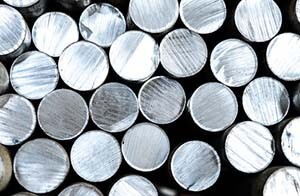With oil back below $50 a barrel, the Chinese economy slowing, and the dollar staying strong, this could look like a terrible time to invest anywhere near the materials space.
In fact, in the wake of petroleum prices dropping more than 50% in less than a year, deflation now stalks the entire global resource ecosystem.
Sell-offs have tanked the price of gold and silver, along with industrial metals like copper and nickel, and even commodities like cotton.
But there’s one materials play that will allow you to buck that trend.
It’s a “pure play” on metals that is all but guaranteed to return you double digits thanks to two major catalysts.
First, this company has announced a spin-off -- it will soon split into two companies so it can free up its performance unit to achieve much faster growth.
And second, it just scored a $1 billion contract from a world leader in commercial aerospace.
Here’s how to invest in this materials firm before these twin catalysts send its shares soaring…
Aluminum Anniversary
 We’re approaching the 130th anniversary of one of the key events in the history of the U.S. metals industry.
We’re approaching the 130th anniversary of one of the key events in the history of the U.S. metals industry.
Back on July 9, 1886, a young Ohio inventor named Charles Martin Hall filed a patent that would in short order transform the industrial world – a way to produce low-cost aluminum by passing an electric current through a bath of alumina dissolved in cryolite.
More than a century later, the process Hall invented (and that was simultaneously discovered in France) remains the only real way to produce industrial-grade aluminum at commercially viable speeds.
And Hall did more than just co-invent aluminum manufacturing. He also founded one of the nation’s oldest materials firms – Alcoa Inc. (NYSE: AA).
This firm’s impact cannot be overestimated.
Alcoa’s aluminum, prized for its light weight and corrosion resistance, essentially made possible the booming automotive and commercial aircraft industries.
But the recent materials downturn put the stock under pressure. Since hitting a two-year closing high of $17.60 last Nov. 24, the stock is off some 42%.
However, I believe the recent announcement that Alcoa will spin off what it simply refers to as its “value add” business will be a potent catalyst that turns the stock around.
Two Great Stocks for the Price of One
By definition, spin-offs are “twofers” for investors. In the case of Alcoa, when you buy shares in the existing firm, you will automatically get shares in this new business as a tax-free special dividend when the deal goes through next year.
And I’m not the only one who sees the profit potential in this move. In the first eight days following news of the spin-off, Alcoa rallied 20%.
That shouldn’t come as a surprise considering how much empirical data shows that spin-offs are excellent catalysts. In fact, two major studies show the market-beating potential in spin-off investing.
In the first study, two professors at Penn State University examined 30 years of market data covering 174 spin-offs. They found that in the first three years of operations, these new companies gained 76%, beating the S&P 500 Index by 31%.
Lehman Brothers also studied the subject extensively. The Wall Street giant studied 85 spin-offs between 2000 and 2005 and found they beat the S&P 500 by as much as 45% in their first two years as independent companies.
Under the Alcoa spin-off, all of the firm’s basic aluminum and related smelting, mining, energy, and production units will form what Alcoa calls its “Upstream Co.” We’ll just call it Old Alcoa.
This unit will finish the year with roughly $13.2 billion in sales, essentially unchanged from last year. Old Alcoa also has acquired vast tracts of energy assets that will add profit margins when oil and gas prices recover.
What I call “New Alcoa” will focus on segments such as aerospace manufacturing, transportation, construction, and engineered products (including products like aluminum wheels and fastenings, thermal coatings, and aluminum sheeting for cars and jets).
And it’s this “downstream” unit that’s causing tech investors to take notice. Here’s why…
Alcoa’s New “Miracle” Aluminum
In addition to being a great spin-off play, the New Alcoa is also a play on “Miracle Materials.”
That’s because the company is using a new process to produce an aluminum that is lighter and stronger than ever before – which makes it a critical resource for modern cars and aircraft, two sectors that, as you’re about to see, are poised for extraordinary growth.
New Alcoa is able to produce this miracle aluminum because the company boasts the world’s most advanced rolling mill. Also called a “micromill,” this machine turns out a metal that is 40% more formable and 30% stronger than legacy aluminum.
[mmpazkzone name="end-story-hostage" network="9794" site="307044" id="138536" type="4"]
You’ll soon begin seeing the fruits of this high-tech innovation on your local highway. The micromilled material will debut in a few weeks on the 2016 F-150 pickup truck made by Ford Motor Co. (NYSE: F).
Ford is using the high-grade aluminum to help cut vehicle weight so it can meet the federal government’s increasing standards for fuel economy.
And with a body made largely of New Alcoa aluminum, this new F-150 will weigh 700 pounds less than previous models – a total weight reduction of 15%.
With the auto industry booming, Alcoa has timed this spin-off perfectly.
September sales came in at an annual rate of 18 million cars and light-duty trucks, and the industry is now on pace to achieve its highest sales since 2000.
We’re seeing a similar development in the commercial aviation space. The industry is striving to cut fuel costs by deploying lighter planes at the very moment it’s beefing up fleets to meet growing global air-traffic demand.
In fact, analysts expect that between now and 2035, the industry will require roughly 38,000 aircraft – worth a combined $5.6 trillion.
And that brings me to the second major catalyst for this stock.
On Oct. 5, Alcoa announced a $1 billion deal to supply bolts, rivets, and other aircraft fasteners for Airbus Group SE (OTCMKTS: EADSY).
The contract will reside with New Alcoa, which will make the fasteners out of titanium, steel, and nickel-based alloys. In a prepared statement, Alcoa CEO Klaus Kleinfeld called the fasteners “breakthrough technologies for some of the most advanced aircraft in the world.”
How We’ll Profit
Alcoa trades at roughly $10.10, giving it a $13 billion market cap, and pays a dividend with a yield of 1.2%.
It’s also gaining momentum as the firm prepares for next year’s spin-off. And that makes it a great long-term “special situation” play.
No doubt, you’d be buying shares in a historic metals firm at a time of depressed materials prices. We saw the impact of that in the third quarter when earnings per share fell 30% to $0.10.
But you also will automatically get shares in the tech-related spin-off as a tax-free dividend.
And as the studies we talked about have proven, we can expect to beat the market over the next three years by roughly 30%.
Thus, it doesn’t take many plays like this to really jump-start your portfolio.
Follow us on Twitter @moneymorning.
Riding the M&A Wave: Mergers and acquisitions are surging in the biotech sector, making it particularly attractive to investors right now. Take advantage of this historic M&A boom with this tech investment. According to history, it’s all but certain to beat the markets over the next two years…
About the Author
Michael A. Robinson is a 36-year Silicon Valley veteran and one of the top tech and biotech financial analysts working today. That's because, as a consultant, senior adviser, and board member for Silicon Valley venture capital firms, Michael enjoys privileged access to pioneering CEOs, scientists, and high-profile players. And he brings this entire world of Silicon Valley "insiders" right to you...
- He was one of five people involved in early meetings for the $160 billion "cloud" computing phenomenon.
- He was there as Lee Iacocca and Roger Smith, the CEOs of Chrysler and GM, led the robotics revolution that saved the U.S. automotive industry.
- As cyber-security was becoming a focus of national security, Michael was with Dave DeWalt, the CEO of McAfee, right before Intel acquired his company for $7.8 billion.
This all means the entire world is constantly seeking Michael's insight.
In addition to being a regular guest and panelist on CNBC and Fox Business, he is also a Pulitzer Prize-nominated writer and reporter. His first book Overdrawn: The Bailout of American Savings warned people about the coming financial collapse - years before the word "bailout" became a household word.
Silicon Valley defense publications vie for his analysis. He's worked for Defense Media Network and Signal Magazine, as well as The New York Times, American Enterprise, and The Wall Street Journal.
And even with decades of experience, Michael believes there has never been a moment in time quite like this.
Right now, medical breakthroughs that once took years to develop are moving at a record speed. And that means we are going to see highly lucrative biotech investment opportunities come in fast and furious.
To help you navigate the historic opportunity in biotech, Michael launched the Bio-Tech Profit Alliance.
His other publications include: Strategic Tech Investor, The Nova-X Report, Bio-Technology Profit Alliance and Nexus-9 Network.



